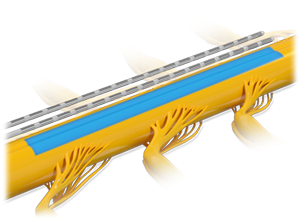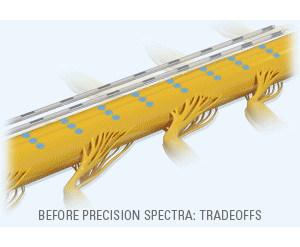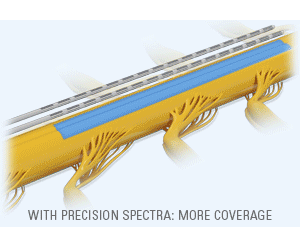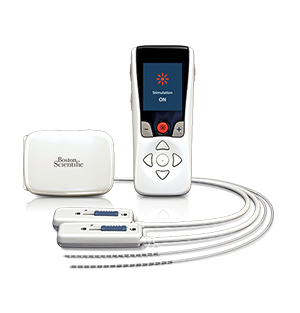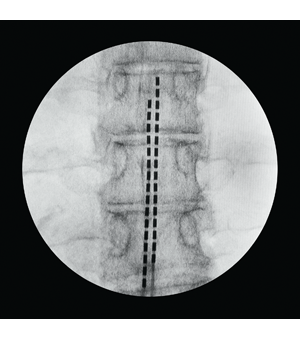Coverage
The world's first SCS system with 32 contacts and 32 dedicated power sources, the Precision Spectra System is designed to provide unprecedented coverage of the spinal cord.
Pain relief starts with pain coverage. In a key study, Dr. Richard North found a strong relationship between pain coverage (paresthesia overlap) and pain relief. And more coverage is what the Precision Spectra System is designed to provide.
32 contacts and 32 dedicated power sources
- With twice the contacts and 32 dedicated power sources, the Precision Spectra System lets you cover more of the spinal cord than ever before.
Seamless coverage for precise targeting
- Two Infinion™ Leads driven by 32 dedicated power sources provide seamless mediolateral and rostrocaudal coverage over three vertebral levels.2,3,4
Before Precision Spectra: Tradeoffs
- Coverage gaps with two widely-spaced 8-contact leads.3,5 Central Points of Stimulation (CPS) with a single power source: 24
- Seamless coverage with less vertebral span.3,5 CPS with a single power source: 45. CPS with 16 dedicated power sources: 70,000
With Precision Spectra: More Coverage
- Two Infinion 16 Leads provide seamless coverage over three vertebral levels.2,4 CPS with 32 dedicated power sources: 150,000
Designed for Optimum Trialing Outcomes
With two Infinion Leads and two 1x16 OR Cables, the Precision Spectra System is designed to give patients the best chance for a successful trial.
- Twice the coverage of the spinal cord with the same number of needle sticks.
- With two Infinion Leads, quickly identify the "sweet spot" for permanent lead placement using Linear™ Leads, the Artisan™ Surgical Lead, or Infinion Leads, Precision Spectra has you covered.
Trial leads migrate.
Precision Spectra has you covered.
In a recent study, trial leads were reported to migrate over one vertebral level (an average of 24.3 mm +/- 11.3 mm).7 In addition, patient non-compliance may result in trial lead migration.
- Seamless coverage of three vertebral levels
- LeadSync™ Technology provides the ability to refocus the stimulation field in the event of relative lead migration
A Central Point of Stimulation (CPS) is the focal point of the stimulation field on the dorsal column. Fractionalizing current in 1% increments between two tightly-spaced contacts provides 100 CPS. Single source systems or widely-spaced contacts provide three CPS between adjacent contacts.2
CPS Calculations:
Image A: 8 CPS x 3 CPS = 24 CPS.
Image B: 15 CPS x 3 CPS = 45 CPS.
700 CPS x 100 CPS = 70,000 CPS.
Image C: 1,500 CPS x 100 CPS = 150,000 CPS
COMPUTATIONAL MODELING METHODS
A volume conductor model of the low-thoracic spinal cord was created, and electric fields were calculated using ANSYS, a finite-element modeling tool. The volume of activation (VOA) and the central point of the VOA were computed and are depicted in these figures.
Only cathodes applied on single or adjacent contacts were used in these models. Computational modeling may not necessarily be indicative of clinical performance.
- North RB et al. Spinal cord stimulation for chronic intractable pain: superiority of "multi-channel" devices. Pain 1991; 44:119-30. Clinical study results may not necessarily be indicative of clinical performance. Retrospective study; n=62.
- Lee D, Bradley K, Syed ZA, Gillespie E, Esterly D. Improved Stimulation Targeting with a Novel 16-Contact Percutaneous SCS Lead: A Computational Model. Abstracts of the 15th Annual Meeting of the North American Neuromodulation Society (NANS) Meeting, Las Vegas, NV, December 2011.
- Lee D, Gillespie E. Dorsal Column Steerability with Dual Parallel Leads using Dedicated Power Sources: A Computational Model. Abstract of the 35th Annual Regional Anesthesia Meeting and Workshops (ASRA), Toronto, Canada, April 22-25, 2010.
- Panjabi M, et al. Thoracic Human Vertebrae: Qualitative Three-Dimensional Anatomy. Spine 1991;16(8):888-901.
- Lee D, Gillespie E. Incremental Movement of the Central Point of Stimulation Beneath a Spinal Cord Stimulation Lead in a Computational Model. Abstracts of the 13th Annual Meeting of the North American Neuromodulation Society (NANS) Meeting, Las Vegas, NV, December 2009.
- Ranu ER, Gillespie E, Bradley K. The Benefits of Tight Contact Spacing: Computational Model on Avoiding Stimulation Gaps. Presented as part of the 14th Annual North American Neuromodulation Society (NANS) Meeting, Las Vegas, NV, December 2-5, 2010.
- Osborne MD, Ghazi SM, Palmer SC, Boone KM, Sletten CD, Nottmeier EW. Spinal Cord Stimulator - Trial Lead Migration Study. Pain Medicine 2011; 12: 204-208. Prospective study; n= 20.











